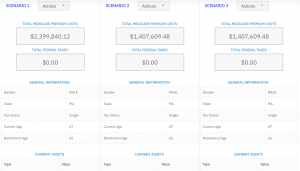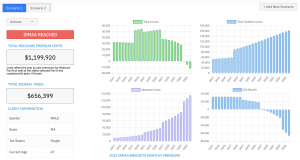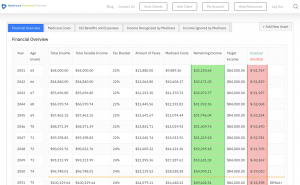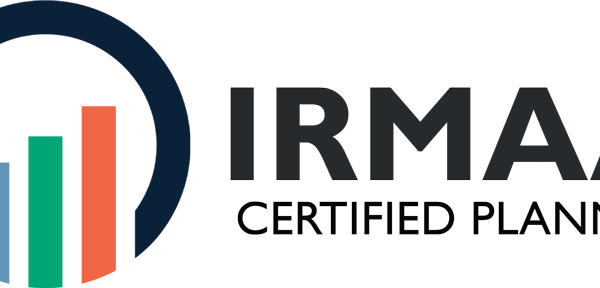Imagine a ticking clock. This clock isn’t ordinary; it’s the master timer governing your financial security in retirement, particularly for healthcare expenses. At the heart of this scenario is Medicare Part D IRMAA. A concept as crucial as it is misunderstood by many. Think about it – a tax on your income through Medicare Part B and Part D coverage if you have too much income in retirement.
Here’s something shocking yet true: By 2030, at least 12.8 million or 25% of all eligible Medicare beneficiaries will be tangled in IRMAA’s grasp according to recent reports from the Trustees of Medicare. Why? Because without this adjustment, Medicare itself faces insolvency within years.
The real kicker? This surcharge can also nibble away at your Social Security benefits, reducing what you thought was securely yours.
If there ever was a time for an awakening about how vital managing IRMAA could be for safeguarding your financial health post-retirement – that time is now.
Understanding Medicare Part D and IRMAA
Let’s unravel the mystery of Medicare Part D and its companion, the Income-Related Monthly Adjustment Amount (IRMAA). Venturing into this realm feels like stepping onto an unfamiliar path for quite a few of us. But fear not, we’re here to guide you through who it impacts and how to navigate these waters.
What is an IRMAA?
Ah, IRMAA. Sounds like a friendly neighbor but in reality, it’s a bit more complicated than that. IRMAA stands for Income Related Monthly Adjustment Amount. In simpler terms? It’s an extra charge on top of your regular Medicare Part B and D premiums if your income sails over a certain threshold.
What parts of Medicare does IRMAA affect?
You might think IRMAA only knocks on one door but actually, it has keys to two: Medicare Part B and D. While everyone with Part B or D could potentially meet IRMAA, not everyone will pay it. Why? Because it all depends on your income level.
Who qualifies for IRMAA?
If you’ve got a treasure chest brimming with gold coins (aka higher income), expect to get acquainted with IRMAA.
Exploring the Cost Implications of IRMAA
Let’s talk dollars and sense. Yes, you read that right. Because when it comes to understanding how much IRMAA costs, we need a bit of both.
How much does IRMAA cost?
The truth? It varies. But one thing’s for sure: nobody likes surprises on their bills. Especially not from Medicare Part B and Part D plans.
IRMAA, short for Income-Related Monthly Adjustment Amount, is like that uninvited guest at your retirement party – popping up when you least expect it if your income dances above certain thresholds.
How much will IRMAA add to my Part B costs?
A little or a lot – depending on where your income lands. If the IRS has pegged you as having more fun than most (read: higher earnings), expect to chip in extra for those Part B premiums. Think of it as buying a pricier ticket to the same show everyone else is watching but with slightly better seats because… well, Uncle Sam said so.
How much will IRMAA add to my Part D costs?
Same song, different verse. Your prescription drug plan under Medicare isn’t immune to the charms of IRMAA either. Imagine this: You’ve got your regular Part D costs, minding their own business, then BAM. Along comes IRMAA sliding into your bill like an unexpected DM – increasing what you pay monthly based on those pesky high-income brackets again.
In 2024, “the amount of people in IRMAA is over a staggering 6 million.” That’s quite the crowd paying extra.
To wrap this up nicely with a bow – getting cozy with these numbers isn’t just smart; it’s essential. Because forewarned is forearmed or financially savvy in our case here at irmaacertifiedplanner.com.
Understanding the importance of astutely handling our nest egg cannot be overstated. And part of that wisdom involves keeping an eye out for sneaky surcharges like IRMAA. So let’s keep learning together and make every penny count.
Key Takeaway:
IRMAA can be a party crasher in your Medicare costs, hiking up what you pay based on income. Get wise to its ways and budget smarter for those unexpected jumps.
Income Considerations for IRMAA
Diving into the nitty-gritty of Medicare’s prescription drug plan, we find ourselves tangled in a web of income brackets and thresholds. Navigating the maze of Medicare’s drug plan means deciphering how your earnings influence what you pay for coverage.
What income counts as IRMAA?
First off, let’s tackle what really matters: What cash flows are under the microscope? The star player here is your Modified Adjusted Gross Income (MAGI). Think of it as your AGI on steroids – adding back certain deductions like tax-exempt interest or non-taxable Social Security benefits. This figure from two years ago decides if you’re paying extra today. So yes, that side hustle or retirement account distribution could tip the scales.
Does ‘Medicare income limits’ mean the same thing as IRMAA?
A little confusion never hurt anybody, right? Wrong. While ‘Medicare income limits’ sounds like something out of an IRS nightmare, it essentially boils down to those MAGI figures determining whether you’ll be writing a bigger check for Part B and D premiums. More specifically, crossing these invisible lines means saying hello to IRMAA – not someone you want at your party unless financial planning is on the agenda.
How is my income used in my IRMAA determination?
This one feels like solving a mystery with clues left behind two years ago by none other than…you guessed it—your past self. Your 2024 tax return plays detective in 2024’s game of “Who Pays More?” If last time around you were living large (we’re talking more than $103k solo or $206k joint), brace yourself for higher premiums this year. But hey, don’t fret just yet; inflation adjustments are our silent guardians adjusting those thresholds annually. Plus there’s always room to strategize and navigate through these financial waters with some savvy planning (find help here).
In essence, deciphering this maze requires patience and perhaps a magic crystal ball—or better yet—a chat with an expert who can guide you through avoiding unwanted surprises come premium time.
Key Takeaway:
Understanding IRMAA is all about getting cozy with your Modified Adjusted Gross Income. This number from two years back decides if you’ll pay more for Medicare Part B and D today. Remember, those side hustles or retirement distributions could bump you into a higher bracket—so plan wisely to avoid surprises.
Navigating through Medicare Advantage and Prescription Drug Coverage
Let’s untangle the web of Medicare Advantage, prescription drug coverage, and IRMAA. It’s like navigating a maze with hidden treasures at every turn if you know where to look.
Medicare Advantage and IRMAA
First off, diving into Medicare Advantage plans. These are the cool kids on the block offering an all-in-one alternative to Original Medicare. But here’s the catch: they still play by some of the same rules as traditional Medicare when it comes to costs.
If your income dances above a certain threshold, say hello to IRMAA – that extra slice of pie tacked onto your Part B and D premiums. Yep, even in this club, higher earners pay more. But don’t let that scare you; knowledge is power.
Medicare Part D Creditable Coverage: Late Enrollment Penalty (LEP)
- Avoiding LEP feels like dodging raindrops – possible but tricky without an umbrella. If you’re late hopping onto a Part D plan after losing creditable coverage (think job-based health insurance), penalties await.
- The longer you wait, the heftier it gets—like accruing library fines for that book borrowed eons ago.
- This penalty sticks around longer than unwanted house guests; we’re talking about as long as you have Part D coverage.
Part D Low Income Subsidy (Extra Help)
In contrast to IRMAA’s thunderclouds hangs a silver lining called Extra Help or Low-Income Subsidy (LIS). This gem helps cover part or all your medication doughnut hole worries including premiums and deductibles for those who qualify based on income criteria.
It’s akin to finding out there was no monster under your bed—it offers peace of mind knowing help is there if needed.
Now armed with these insights on how Medicare Advantage intertwines with prescription drug coverage—and tools available—you can stride confidently forward into making informed choices about your healthcare journey.
Key Takeaway:
Master Medicare Advantage and prescription drug coverage by understanding IRMAA, dodging late enrollment penalties, and using Extra Help. Knowledge is your treasure map in this journey.
Appealing IRMAA Determinations
Let’s face it, getting hit with an Income-Related Monthly Adjustment Amount (IRMAA) can feel like a low blow. Especially when you’re already juggling the costs of retirement.
How to appeal IRMAA
First off, don’t panic. There’s a pathway carved out for this exact scenario. If you think your IRMAA was calculated on shaky ground, appealing is definitely within your rights.
- Step 1: Gather your evidence. This could be anything from amended tax returns to proof of a life-changing event affecting your income.
- Step 2: Get in touch with the Social Security Administration (800-772-1213). They’re the gatekeepers here and will guide you through submitting your appeal.
- Step 3: Patience is key. These things take time but stay on top of it by checking in regularly on the status of your appeal.
What can I do if I don’t think I should pay an IRMAA?
If that IRMAA notice has got you scratching your head thinking there’s been some mistake, acting swiftly is crucial. You have every right to question it and more importantly, challenge it if something seems off base with their calculations or based on outdated information about you.
Situations ripe for an appeal include:
- The SSA used incorrect or outdated tax info;
- You’ve had significant changes in income due to life events like retirement or loss of employment;
Note:
You must request an appeal at your local SSA office. Make sure they know why you’re disputing their determination—be clear and precise.
Diving deeper into the intricacies of Medicare can be found on this page.
Find an expert near you who specializes in these appeals; sometimes having someone versed in these waters can make all the difference.
Exploring Extra Help with Medicare Prescription Drug Plan Costs
An overview of the ‘Extra Help’ program that assists with costs related to Medicare’s prescription drug plan, including eligibility criteria and potential savings.
Apply for Medicare Part D Extra Help program
Let’s get straight to it. Applying for Extra Help can feel like navigating a maze in the dark. But here’s your flashlight: The application process isn’t as daunting as you might think.
You start by visiting the Social Security Administration website or giving them a call. It’s about proving you’re eligible based on income and resources – but don’t sweat, many find they qualify when they thought they wouldn’t.
Who gets Extra Help automatically?
- If you have full Medicaid coverage,
- If you’re getting help from your state paying your Part B premiums (that’s part of what we call ‘Medicare Savings Programs’), or
- If Supplemental Security Income benefits are something you receive,
Congratulations. You’ve already got one foot through the door without lifting a finger for this extra help.
What you’ll pay under Extra Help in 2024
Predicting exact numbers is tricky – it feels almost like trying to guess next week’s weather accurately. However, if past trends hold true, those qualifying for ‘Extra Help’ could see significant reductions in their out-of-pocket expenses related to their medicare prescription drug plan costs.
- Lower (or no) premiums? Check.
- Deductibles taking a dive? Absolutely.
- Copayments crumbling away? You betcha.
This hidden treasure ensures your wallet stays fuller, by keeping more cash in it. Apply for extra help , and make managing healthcare costs just that bit easier.
Conclusion
So, we’ve taken a whirlwind tour through the world of medicare part d irmaa, slicing through jargon like a hot knife through butter. It’s been quite the journey – from demystifying what IRMAA really is to unearthing how it affects your Medicare Part B and D plans.
We discovered that while IRMAA might seem like just another acronym in an alphabet soup of government programs, it plays a pivotal role in shaping our healthcare costs during retirement. And yes, managing it effectively can feel akin to performing high-wire acrobatics without a net. But armed with knowledge about income considerations and appeals processes, you’re now better equipped than ever before.
Navigating the maze of financial planning isn’t merely a quest to pinch pennies or dodge extra fees; it’s an endeavor to guarantee serenity in your retirement era. By understanding medicare part d irmaa inside out – from its cost implications to exploring avenues for extra help – you’ve set yourself up not just to survive but thrive.
Think smart assistants making life easier – only this time around, it’s savvy planning ensuring your retirement funds aren’t nibbled away by unexpected charges. You’ve got the tools at hand: use them wisely and let’s keep those Social Security benefits as intact as possible!
Feeling accomplished? You should be! We’ve unpacked complexities together because when information turns into action, that’s where real magic happens in safeguarding our future health care needs. So here’s to navigating Medicare with confidence – may your financial health flourish alongside your physical well-being!
Table of Contents:
Streamlining the Medicare Surcharge Calculation Process.
Our Healthcare Retirement Planner software is designed to streamline the retirement planning process for financial professionals. By providing an efficient way to calculate IRMAA costs, our tool helps you save time and focus on other aspects of your clients’ retirement plans.
- Faster calculations: Our software quickly calculates IRMAA costs based on your client’s income and tax filing status, eliminating manual calculations and potential errors.
- User-friendly interface: The intuitive design of our platform makes it easy for financial professionals to input data and generate results with minimal effort.
- Data integration: Seamlessly integrate our calculator into your existing financial planning tools or CRM systems for a more streamlined workflow.
- Easy to Understand Reports: Export reports to easily share with your clients
- Tax and Surcharge Modeling: see how different types of income affects both taxes and your surcharges.
In addition to simplifying the calculation process, using our Healthcare Retirement Planner can also help improve communication between you and your clients. With clear visuals that illustrate how IRMAA costs impact their overall retirement plan, you can effectively convey complex information in an easily digestible format. This enables clients to make informed decisions about their healthcare expenses during retirement while ensuring they are prepared for any potential changes in Medicare premiums due to income fluctuations. To learn more about how our software can benefit both you as a financial professional and your clients’ retirement planning experience, visit the features page. Streamlining retirement planning processes can help financial professionals save time and resources, allowing them to focus on other areas of their clients’ needs. Automated calculation of IRMAA costs is the next step in streamlining this process even further.






